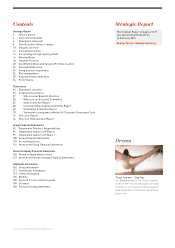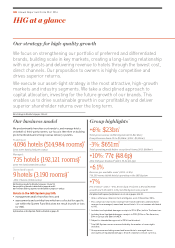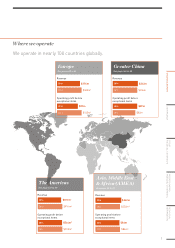Holiday Inn 2014 Annual Report Download - page 12
Download and view the complete annual report
Please find page 12 of the 2014 Holiday Inn annual report below. You can navigate through the pages in the report by either clicking on the pages listed below, or by using the keyword search tool below to find specific information within the annual report.
Where the industry is now
The global hotel industry
The global hotel industry comprises approximately 15.5 million
rooms and is broadly segmented into branded (multiple hotels
under the same brand name) and independent (non-branded)
hotels. Growth in demand is driven by economic growth and an
increasing trend for domestic and global travel, resulting in part
from favourable demographics and the globalisation of travel.
Over the long term, the lodging industry has grown broadly in line
with Gross Domestic Product (GDP). In the US market (which is the
largest market in terms of number of rooms), growth in consumer
spend on lodging has exceeded GDP growth by two percentage
points per annum over the last 50 years.
There are a number of industry metrics that are widely recognised
and used to track performance and we actively monitor these.
These include revenue per available room (RevPAR), average daily
rate and rooms supply growth.
Global industry RevPAR growth (2014 v 2013)
4.4%
5.9%
2013
2014
IHG’s Key performance indicators (KPIs) are set out on pages 30 to 33.
The branded hotel market
The branded hotel market is estimated to account for 53 per cent
of the total hotel market. We benchmark our performance against
the largest branded players that we consider to be our peer group,
with a similar system size and pipeline to ours and who operate in
similar market segments to us (as explained on page 18).
Five of the leading branded hotel companies (IHG, Accor, Hilton,
Marriott and Starwood) account for approximately 30 per cent
of the total branded hotel market in terms of open rooms, and
65 per cent of the development pipeline (hotels in planning
and under construction but not yet open).
In the US, around 70 per cent of the industry supply is branded.
In fast developing markets, such as China and India, penetration
of international brands is, however, lower, at around 45 to 55 per
cent. This level of international brand penetration is expected to
increase significantly over the coming decades, as large global
branded hotels gain traction due to the advantages of reliability,
guest safety and security, consistency of standards and the ability
to invest in customer experience and technology. IHG has
measures in place for all of these – see Our Strategy and
Managing Risks on pages 14 to 29.
IHG’s 2015 Trends Report: Building Trust Capital:
The new business imperative in the Kinship Economy
– released in January 2015
The third in our series of
Trends Reports focused
on consumer insights
impacting the hospitality
industry and business
in general.
Our 2015 Report identifies
the importance for
companies to build brand
and organisational trust.
It demonstrates how to
build Trust Capital with different demographics and across
different geographies, unveiling a blueprint of seven principles
for making it the core driver of an organisation.
Further details about all three Trends Reports can be found at
www.ihgplc.com/trends_report
Source: Smith Travel Research for all of the above industry facts.
The different business models within the hotel industry
The global hotel industry operates under a number of different
business models, depending on whether a hotel is branded or
independent. The four models typically seen are owned, leased,
managed and franchised:
• owned hotels are owned and operated by an owner who bears
all the costs associated with the hotel but also benefits from
all of the income;
• a leased model is similar, except that the owner-operator
of a hotel does not have outright ownership of the hotel but
pays rental fees to the ultimate owner of the property;
• under a managed model, the owner of a hotel uses a third-party
manager to operate the hotel on its behalf and pays the manager
management fees and, if the hotel is operated under a
third-party brand name, brand licensing fees; and
• a franchised hotel is owned and operated by an owner under
a third-party brand name, and the owner pays a brand licensing
fee to the brand owner.
Other models, such as pay-for-performance or commission-
based, are sometimes used by independent hotels to benefit
from a brand’s booking distribution system (for example,
hotel collections).
Whilst an owner-operated hotel enables the owner to have full
control over the hotel operation, it requires high capital investment.
In contrast, for hotel brand owners, a managed or franchised
model enables quicker rooms growth due to the lower capital
investment, but this requires strong relationships with third-party
hotel owners. As a franchisor and manager, we therefore recognise
that our owner proposition is a key part of our strategy.
IHG’s business model, which is a predominantly managed and
franchised model, is set out on pages 12 and 13.
10
IHG Annual Report and Form 20-F 2014
Industry overview
























